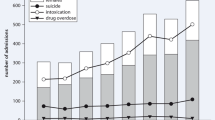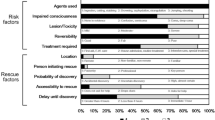Abstract
Purpose
Many elderly patients arrive at the emergency department (ED) complaining of deliberate self-poisoning (DSP). This study determined the poisoning severity of elderly patients who committed DSP.
Methods
A study was performed with 1329 patients (> 15 years of age) who were treated for DSP at two EDs between January 2010 and December 2016. We classified these patients into two groups based on age (an elderly group ≥ 65 years of age and a nonelderly group). Information was collected on age, sex, cause, ingestion time, drug type, suicide attempt history, initial poisoning severity score (PSS), final PSS, outcome, etc.
Results
In total, 242 (18.2%) patients were included in the elderly group, of whom 211 (86.9%) were treated for a first suicide attempt. Admission to the intensive-care unit (ICU) (43.8% vs. 25.5%) and endotracheal intubation (16.1% vs. 4.9%) occurred more frequently in the elderly group than in the nonelderly group (p < 0.001). The frequencies of initial severe PSSs (3 and 4) in the elderly group were 9.1% (N = 22) and 1.2% (N = 3), respectively. Multivariate logistic regression analysis showed that the ICU admission of DSP patients was significantly associated with being elderly (OR of 1.47, 95% CI 1.04–2.09, p = 0.029) and with having a GCS of < 13 (OR of 2.67, 95% CI 1.99–3.57, p < 0.001) and an initial PSS of (3,4) (OR of 3.66, 95% CI 2.14–6.26, p < 0.001). In addition, the presence of underlying diseases (coronary heart disease and cerebrovascular disease) yielded high ORs [(OR of 13.13, 95% CI 2.80–61.57, p = 0.001), (OR of 7.34, 95% CI 1.38–39.09, p = 0.020)].
Conclusion
Elderly patients who visited the ED for DSP exhibited overall more severe PSSs and poorer in-hospital prognosis than did nonelderly DSP patients.

Similar content being viewed by others
Abbreviations
- ED:
-
Emergency department
- DSP:
-
Deliberate self-poisoning
- PSS:
-
Poisoning severity score
- ICU:
-
Intensive-care unit
- GCS:
-
Glasgow coma scale
- MDD:
-
Major depressive disorder
- DBP:
-
Diastolic blood pressure
- PR:
-
Pulse rate
- RR:
-
Respiratory rate
- SBP:
-
Systolic blood pressure
- EMS:
-
Emergency medical services
- IQR:
-
Interquartile range
- ORs:
-
Odds ratios
- CI:
-
Confidence interval
References
Mühlberg W, Becher K, Heppner HJ et al (2005) Acute poisoning in old and very old patients: a longitudinal retrospective study of 5883 patients in a toxicological intensive care unit. Z Gerontol Geriatr 38:182–189
De Leo D, Padoani W, Scocco P et al (2001) Attempted and completed suicide in older subjects: results from the WHO/EURO Multicentre Study of Suicidal Behaviour. Int J Geriatr Psychiatry 16:300–310
Waern M, Rubenowitz E, Runeson B et al (2002) Burden of illness and suicide in elderly people: case–control study. BMJ 324:1355
Harwood DM, Hawton K, Hope T et al (2006) Life problems and physical illness as risk factors for suicide in older people: a descriptive and case-control study. Psychol Med 36:1265–1274
Life expectancy at birth (2016) IOP Publishing Korean Statistical Information Service. http://kosis.kr/statHtml/statHtml.do?orgId=101&tblId=DT_1B41&conn_path=I2. Accessed 28 Apr 2018
Korea Suicide Prevention Center Research (2017) IOP Publishing spckorea. http://www.spckorea.or.kr/index.php. Accessed 28 Apr 2018
Lim JY, Lee DH (2018) Characteristics of drugs ingested for suicide attempts in the elderly. J Korean Med Sci 33:e86. https://doi.org/10.3346/jkms.2018.33.e86
Persson HE, Sjöberg GK, Haines JA et al (1998) Poisoning severity score. Grading of acute poisoning. J Toxicol Clin Toxicol 36:205–213
Juurlink DN, Herrmann N, Szalai JP et al (2004) Medical illness and the risk of suicide in the elderly. Arch Intern Med 164:1179–1184
Quan H, Arboleda-Flórez J, Fick GH et al (2002) Association between physical illness and suicide among the elderly. Soc Psychiatry Psychiatr Epidemiol 37:190–197
Waern M, Rubenowitz E, Wilhelmson K (2003) Predictors of suicide in the old elderly. Gerontology 49:328–334
Waern M, Runeson BS, Allebeck P et al (2002) Mental disorder in elderly suicides: a case-control study. Am J Psychiatry 159:450–455
Bonner RL, Rich AR (1987) Toward a predictive model of suicidal ideation and behavior: some preliminary data in college students. Suicide Life Threat Behav 17:50–63
Suokas J, Suominen K, Isometsä E et al (2001) Long-term risk factors for suicide mortality after attempted suicide–findings of a 14-year follow-up study. Acta Psychiatr Scand 104:117–121
Turnheim K (2003) When drug therapy gets old: pharmacokinetics and pharmacodynamics in the elderly. Exp Gerontol 38:843–853
Xu S, Hu H, Jiang Z et al (2015) APACHE score, Severity Index of Paraquat Poisoning, and serum lactic acid concentration in the prognosis of paraquat poisoning of Chinese Patients. Pediatr Emerg Care 31:117–121
Akdur O, Durukan P, Ozkan S et al (2010) Poisoning severity score, Glasgow coma scale, corrected QT interval in acute organophosphate poisoning. Hum Exp Toxicol 29:419–425
Davies JO, Eddleston M, Buckley NA (2008) Predicting outcome in acute organophosphorus poisoning with a poison severity score or the Glasgow coma scale. QJM 101:371–379
Picetti E, Generali M, Mensi F et al (2018) Glyphosate ingestion causing multiple organ failure: a near-fatal case report. Acta Biomed 88:533–537
Acknowledgements
The authors wish to acknowledge the financial support of the Catholic Medical Center Research Foundation during the program year of 2018.
Author information
Authors and Affiliations
Contributions
SH, JHW, and WJL performed data analysis and drafted the manuscript. DHK, SHW, and HWL acquired data and critically revised the manuscript. SKI, JYL, and SHS managed the data and revisions to the manuscript. All authors read and approved the final manuscript.
Corresponding author
Ethics declarations
Conflict of interest
The authors do not have any financial or other relationships that might pose any conflicts of interest.
Statement of human and animal rights
All procedures performed in studies involving patients were in accordance with the ethical standards of the institution and/or national research. The protocol was approved by the Institutional Review Board of Incheon St. Mary’s Hospital.
Informed consent
Because the clinical measurements were part of routine patient management in the emergency department, informed consent was unnecessary, which was confirmed by the Institutional Review Board.
Rights and permissions
About this article
Cite this article
Hong, S., Lee, W.J., Kim, D.H. et al. Elderly patients visiting the emergency department for deliberate self-poisoning: do they present a more severe poisoning severity score than the nonelderly patients in the initial 24 h?. Aging Clin Exp Res 31, 1139–1146 (2019). https://doi.org/10.1007/s40520-018-1053-3
Received:
Accepted:
Published:
Issue Date:
DOI: https://doi.org/10.1007/s40520-018-1053-3




